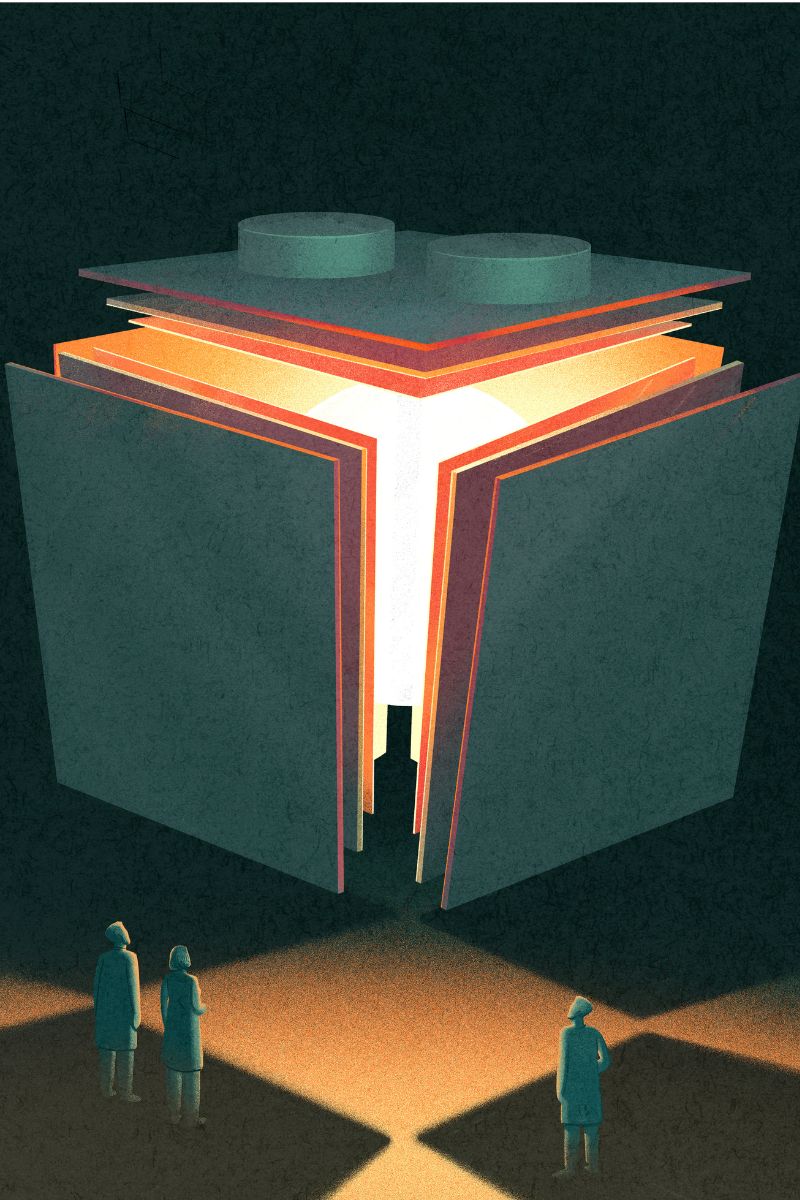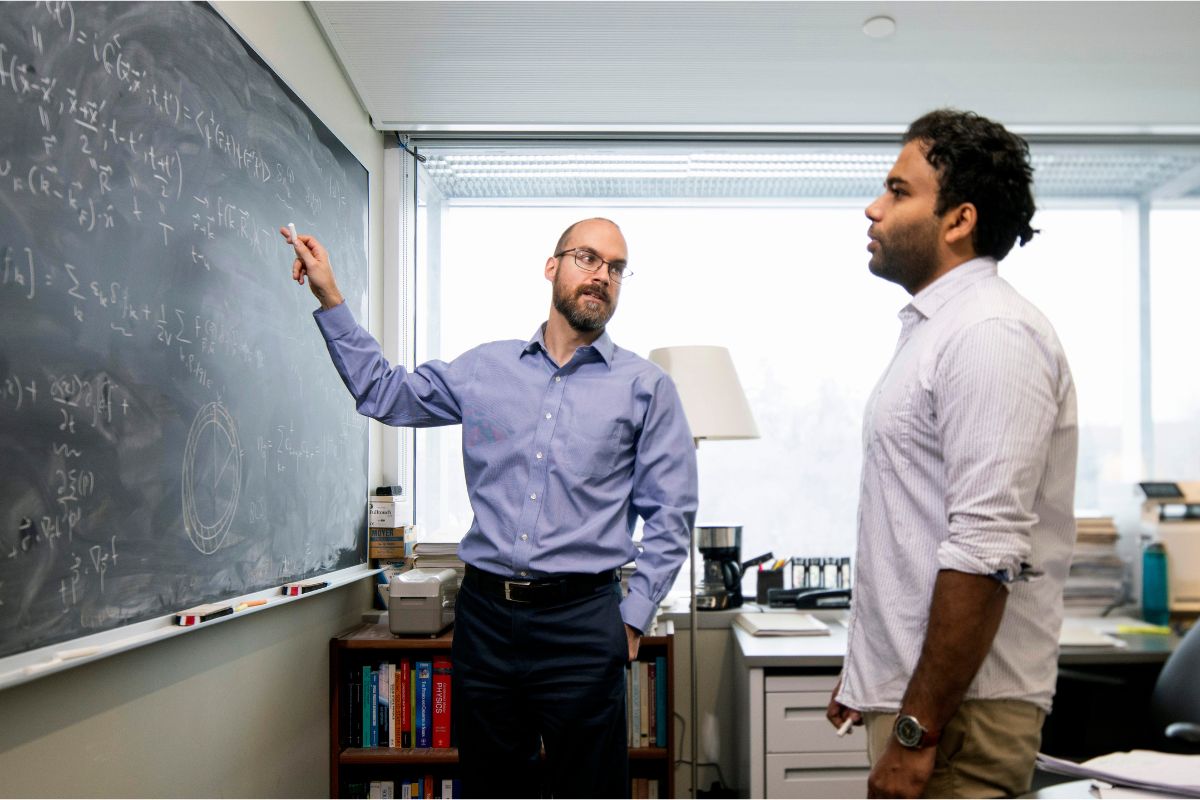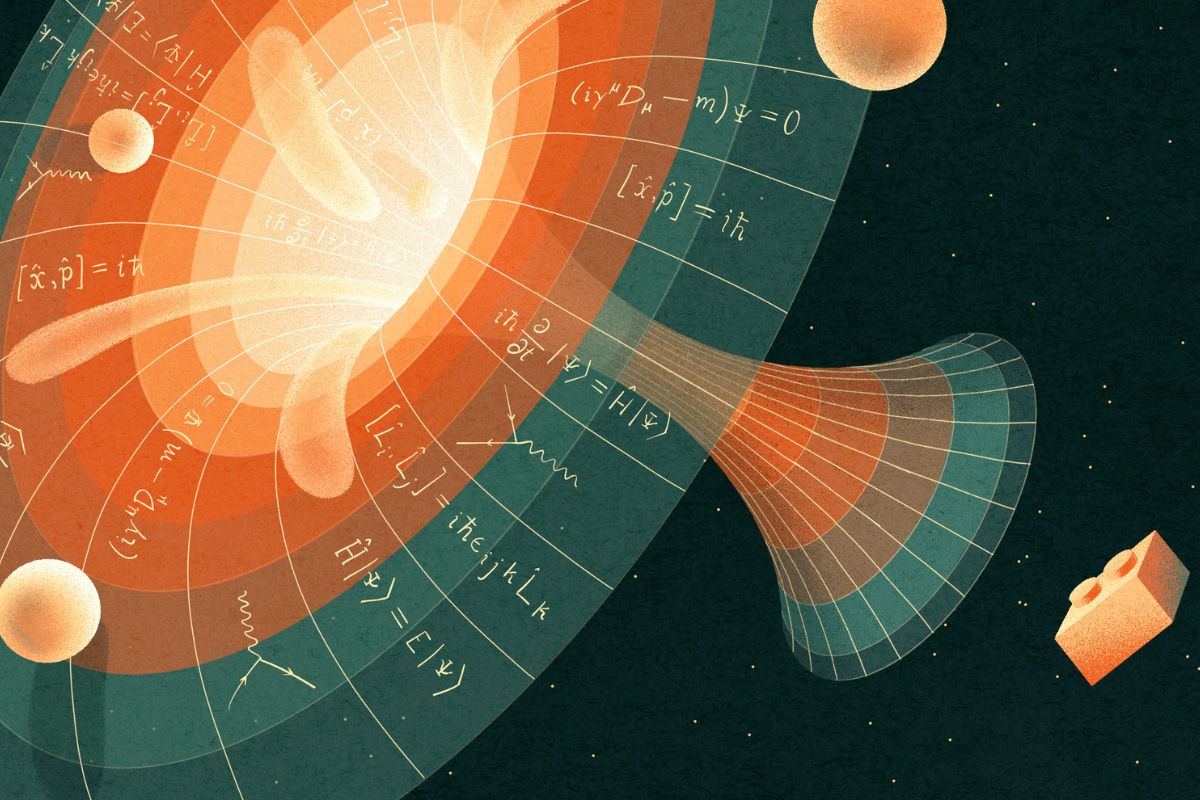
Illustrations: Myriam Wares
When’s the last time you played with LEGO? You probably started by pouring out the bags of tiny, mismatched pieces into a pile of plastic nonsense on the floor and flipping open the construction manual to begin. Maybe you sorted the pieces neatly first. Or maybe you dug through the pile of nonsense for the particular piece you needed as your build progressed. Either way, you were likely confident you could create that castle, spaceship or historical monument pictured on the box — even if you weren’t thinking too deeply about what it really took for the LEGO to exist, right there in front of you, on your living room floor.
“To understand things you can touch, you need to understand things that you cannot touch,” explains Joseph Maciejko, associate professor in the Department of Physics and interim director of the University of Alberta node of Quantum Horizons Alberta.
To construct even a simple structure out of LEGO, you first need to understand how to put the little bricks together. The same is true for the kind of quantum science that results in innovative advances that change our world — you’re trying to get to a deeper understanding of how matter behaves in this world, how electrons talk to each other and react in different scenarios. You need to understand the rules before you can put together a solid structure, explains Maciejko.
In order for a tangible LEGO figure to sit on a shelf in your house, a lot had to be understood to get it there. Your job was to read the construction manual and understand how the bricks click together, but a product designer had to use their knowledge of engineering to come up with the design concept, a fabricator needed to know what the bricks were made of (not to mention a ton about mechanics) to program the moulding machines that superheat plastic granules to press the bricks into shape, and a scientist needed to have a complex understanding of chemistry to make the granules that went into those moulds. It goes on and on.
The same goes for complex quantum technologies like an MRI machine. There are layers and levels and centuries of knowledge supporting the creation of an object or piece of tech, and when the layers are peeled back, you’ll eventually arrive at the foundation: some principle of basic science that was discovered simply through experimenting with thought. For example, the basic principle behind LEGO is polymer chemistry, and for an MRI machine, it’s condensed matter physics.
Maciejko describes the relationships of basic science to applied science as a pipeline. “The fundamental science of today is the applied science of tomorrow,” he says. “If we cut that pipeline, at some point applied science is going to run out. We’re going to run out of ideas, of inspiration.”
The Small Stuff
Quantum science studies the properties and behaviours of the tiniest building blocks of the universe, exploring the world beyond what we perceive around us. It underpins all other science, but we don’t know that much about it.
Of course, we do know some things about it. Otherwise, we would be without technologies such as sensors and lasers, which are used for anything from rotating an image on your smartphone depending upon the way you’re holding it (thanks, sensors!) to precision surgery to improve your eyesight (thanks, lasers!). These technologies made their way from the lab to the real world because of applied and experimental quantum science research — the same brands of research that will soon make quantum computing mainstream.
But these tangible technologies are just a few parts of the larger quantum research pipeline — theoretical research is needed to advance the field and extend the boundaries of knowledge in the quantum realm and open untold and unpredictable possibilities.
“To make the most of applied quantum technology, you need to work backwards,” Maciejko says.
He explains that before the first monolithic integrated circuit behind the modern computer microchip was made, Robert Noyce needed to decide on the material it was made of. To do that, Noyce needed an understanding of the properties of certain materials that make them best suited to the job at hand — knowledge that’s in the territory of theoretical quantum physics.
“You have to think about them and you need mathematics and science to describe things that you can’t really see with your naked eye. This is where the theory comes in,” Maciejko says.
While experimental and applied quantum physicists can test their hypotheses and ideas in the lab through experiments, theoretical quantum physicists work solely in the realm of thought. That makes collaboration a critical part of the process.
“That’s how we theorists experiment. We experiment with thought, and so we need to bounce ideas around,” Maciejko says.
A Literal Home for the Theoretical
Quantum Horizons Alberta (QHA), a new $25-million, provincewide network created in a partnership between the universities of Alberta, Calgary and Lethbridge, will allow that kind of collaboration between theoretical researchers to flourish. Supported by a group of visionary donors, the network is dedicated to advancing fundamental, theoretical quantum science.
While Alberta is already home to quantum research and innovation excellence, QHA is unique because its focus is on building the capacity of theoretical quantum research in Alberta.
“Our chances of achieving greatness, our chances of achieving a position on the world stage in quantum research, are much greater the more resources within the province we can gather,” says Richard Bird, one of five donors behind QHA (with Joanne Cuthbertson, Patrick Daniel, Guy Turcotte and Mac Van Wielingen). “We wanted to make sure we have the benefit of the bench strength that already exists in all three universities,” Bird says.
The U of A alone already has $100-million-worth of infrastructure and equipment needed to support basic quantum research and training. QHA will allow these universities to expand their social infrastructures by recruiting and partnering with professors, postdoctoral researchers and trainees from other universities and countries.
This is key because all quantum scientists, not just theorists, are trying to answer increasingly complex questions, and as a result, no single researcher has all the required knowledge. Collaboration is needed among scientists working in various branches of quantum.
During the QHA donors’ initial discussions, they learned that most funding for quantum science was going into applications and commercialization, and they realized that focusing their funding dollars in another direction would allow them to make a greater impact.
“There was a real gap in the funding for foundational or theoretical quantum science,” Bird says. “All the academics we spoke to said we can only go so far developing applications based on what we already know. Eventually, we need to better understand the foundations of this area of science.”
“You cannot do applied science without fundamental science, because all of applied science at some point relies on fundamental science,” Maciejko says. “Like mechanics and Newton’s laws: they are applied science now but were fundamental science in the 1700s.”
The donors are eager to establish Alberta as a key source of research and discoveries in a field that promises to transform the human condition.
And while it may take years, even decades, for fundamental quantum science research to produce everyday applications, Cuthbertson thinks Alberta is the perfect place to make it happen.
“We have a milieu of magical ingredients in Alberta that make us a special place for investment and doing very big things,” Cuthbertson says. “Alberta has the talent and experience, and the right mindset. We have eyes for opportunities. We have experience with starting something small and growing it into something large. We have a lot of respect for the relationship between making an investment and reaping a reward. And, very notably, we have a tolerance for risk-taking.”
The good news is, even while we work towards and wait for those reality-changing, foundational discoveries, initiatives like QHA have the potential to attract experts to Alberta from around the world, significantly building and diversifying our economy — and maybe even establishing Canada as a destination for big-deal quantum discoveries.
This is why Cuthbertson and her fellow donors prioritized a partnership model for QHA and expect that the group will continue to expand as supporters from across Canada join the initiative.
The Unknown Realm
The quantum realm is home to fascinating possibilities like unbreakably secure communications, efficient computation for difficult optimization problems and unprecedented measurement sensitivity, many of which are research areas in Alberta today.
Another area of ongoing Alberta-based research is quantum computing.
Scientists see this yet-to-be-realized technology as the key to cracking many as yet intractable problems as well as a possible solution to the world’s insatiable need for computing power. While regular computing uses binary digits, a.k.a. bits, where each bit can store one piece of information — it’s either a zero or a one — quantum computing uses quantum bits, called qubits [kyoo-bits]. Thanks to a quantum property called superposition, qubits level up the standard binary code. Rather than being either zero or one, they can be both at the same time.
While the era of quantum computers is near, that doesn’t mean you’ll be able to grab one at Best Buy soon. Quantum computers will likely be bespoke (not to mention physically gigantic and extremely cold) systems that serve very specific purposes for very specific businesses — such as defence or cybersecurity. Large companies and governments around the world are fervently working to develop their own quantum computers as we speak. Once they figure it out, it will make the decryption and cryptography systems we currently rely on seem quaint and antiquated.
On the flip side, though, quantum computing will also provide more security than we’ve ever imagined. Because of the complexity of qubits, any attempt to look at, or hack, protected information stored by a quantum computer will destroy the copied information before the hacker can see it. Innovations in this sphere could help keep our data, from health care to banking, safer than ever.
Experts like Maciejko are working in the field of topological materials to study exotic new materials with distinct properties that could be the key to the next generation of devices. Experts in Alberta are also studying materials like superconductors that can conduct electricity perfectly — with zero electrical resistance and without losing energy, creating heat or experiencing deterioration of materials. There’s also particle physics, which studies the fundamental building blocks of nature by looking at matter in its most minute form, at the subatomic level, and quantum sensing and communications. Quantum sensing measures physical quantities such as electric and magnetic fields, chemical processes and temperature with tremendous accuracy and precision. It promises to give us new insight into what’s in our bodies, in the ground and all around us.
But unlike these examples of experimental and applied quantum research, the tangible results of today’s fundamental, or basic, quantum science research are completely unknown. The unknowns make the investment and the field more intriguing as a fruitful way to advance humanity.
It’s a tale as old as time: people prefer to invest in a solution for *insert a very specific and scary issue here* rather than basic research. It’s easy to understand why it seems more meaningful and actionable to donate with an aim to solve a specific and circumscribed problem than donate to a group of scientists “experimenting with thought.” While we all definitely want to cure diseases and address global issues, the truth is that fundamental research has the potential to lead us to a whole new scientific reality that presents opportunities to solve big problems.
Imagine what it was like to discover electricity, the atom or the molecular structure of DNA. Those discoveries, which came from fundamental, theoretical research, were transformational to the human condition. They changed the way we understand, experience and live in our world. They gave us completely novel information to work with to better it.
Fundamental quantum science research has the potential to make more of those world-changing discoveries. The ones that have the potential to provide solutions for today’s confounding problems — and future problems we haven’t even faced yet.
It will take decades for advances in quantum science to move from the realm of thought to the real world. But without the theoretical and fundamental components, we’re missing key pieces of the puzzle, Maciejko says.
As with LEGO, before we could contemplate building a model of the Millennium Falcon from tiny plastic bricks, we needed to make the discoveries that underpin the creation of our favourite building toy. Making those discoveries that lead to those pieces? That will change everything — and bring the amazing and unimaginable to life.

